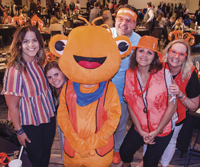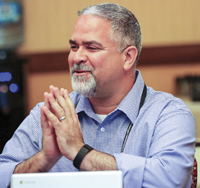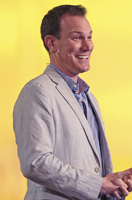Stimulating Success Through Our Human Linkages
June 01, 2022
Role modeling positivity, deepening social connections and focusing on relationships, as suggested by the author of The Happiness Advantage

When Maasai warriors of Kenya, some of the fiercest and most intelligent fighters in history, greet each other, they do not say, “How are you?” as we do in Western cultures. Instead, they ask, “How are the children?” Even for those
without children, the proper answer is, “All the children are well.” That’s because, according to their social script, things can’t be fully good for one individual unless everyone in the community is thriving.
The
science validates this approach. The more challenging the environment, the more we need to follow the advice captured in SEEDS: Surround ourselves with positive leaders; Enhance the ecosystem; Expand power out; Defend against the negatives; and Sustain
the wins.
In nature, when fireflies light up individually and randomly in the dark, their success rate at reproduction is 3 percent, but when they light up together, timing their pulses to the millisecond, their success rate skyrockets
to 82 percent. At Harvard, the greatest predictor we found of long-term success and happiness among students was social connection to the ecosystem.
Based on a decade of Big Data and community interventions, it seems increasingly evident
that to achieve higher potential, the eco-system must be strengthened.
Creating the conditions for success and effectively managing a system that can respond to needs and crises, support significant change and deliver educational outcomes starts
at the top.
The Positivity Advantage
A positive outlook is key to academic and professional success as well as mental and emotional health, especially during challenging times. When the human brain turns to “positive,” virtually every performance indicator we know how to measure
improves.
Happiness significantly improves memory, attention and productive energy, while lowering stress and increasing resiliency.
Moreover, once we start capitalizing on the “happiness advantage” in our own lives, the positive changes quickly ripple out to others. And this means educating not only our students, but also parents on how much of their child’s
success is built upon cultivating an optimistic, engaged, connected and hopeful mindset. While this looks different for different leaders, several exemplary educators today are modeling positive habits, breaking negative social scripts and overcoming
uncertainty to enable significant changes to unfold.
Role Modeling
On March 12, 2020, at that night’s school board meeting in response to the outbreak of COVID‑19, Michael Lubelfeld, superintendent of North Shore School District 112 in Highland Park, Ill., declared the district would be extending spring break with
classes resuming on Monday, April 14. The next day a statewide shutdown was announced, and Lubelfeld was asked to join the governor’s statewide task force, a think tank of sorts on dealing with the emerging pandemic.
The following
day, Lubelfeld instituted a weekly meeting with teachers (that continues today), dedicated to respectful and honest conversations about what was happening. Synthesizing everything through the core lens of a leader, he was determined that communication
be clear and continual.
“We did not know what was going on, but we knew something was going on,” Lubelfeld says. “And I wanted to establish a positive mindset and be conscientious about messaging and anticipated outcomes.”
He brought the voice of a rational optimist to his staff. And that positive voice carries.
Lubelfeld also participates in book studies with staff members (he calls it “adult SEL”) and conducts a podcast where he frequently
engages with students and teachers. He intentionally tweets positive-only messages. He also consistently writes handwritten notes of gratitude, appreciation and condolence. These are prime-time examples of role modeling positivity to the entire district.

Altering Social Scripts
Changing the prevailing social scripts, often negative, is another way to take the lead in role modeling positivity during challenging times. Again, it’s a matter of doing, not just saying.
Joel Pedersen is superintendent of Cardinal
Community School District in Eldon, Iowa, located in what The Wall Street Journal reported to be one of the poorest counties in Iowa. The school district ranked in the bottom 10 percent academically when Pedersen took office in 2010. At the time,
ACT scores averaged 6 points below the state average, and enrollment was dropping as families fled Cardinal’s schools. There was little to be proud of.
“I knew that if I could change behaviors by demonstrating more positive
ones, mindsets would follow,” Pedersen says. “I realized that top-down messaging, problem solving and mandating were not going to change the well-established belief system that ‘We’re just Cardinal.’ We needed new
skills put into action.”
Not having a formal training program to begin with, he did the next best thing. He looked to key staff who already were positive leaders, the ones who had influence in the district — who I call “positive
outliers.” They learned the principles of positive psychology first through a book and program I created based on a parable called The Orange Frog and then took intentional actions. Pedersen shared positive stories from the successes
they generated with teachers, support staff, students and parents.
“Each of us, then all of us, began to apply the principles and form new positive habits in our daily work,” he says. “That had a big impact. It became
contagious. Changing the prevailing social script to positive first caught on, and after a while, everyone wanted a piece of the action.”
Pedersen changed the social script to one that communicates two key things: (1) what you
think matters and (2) what you do matters. Research by Gallup indicates that when a leader can convey such guidance and direction about an achievable future, people are 69 times more likely to engage.
And they have in the 1,050-student
Cardinal district. Academic performance and open enrollment have improved significantly. ACT scores improved on average by 3.5 points, and the district had one of the highest literacy score changes in the state. Pedersen was Iowa’s 2020
superintendent of the year, and in 2021 Cardinal was ranked as one of the top workplaces in Iowa by the Des Moines Register for the second year in a row.
Make no mistake, leaders play a powerful role in shaping culture. We explore the
world around us by imitating others, especially a trusted leader who helps us see and understand our current conditions.
Deepen Connections
Our social support network is our piggy bank of positivity in light of challenges, stressors and especially crises. We create culture in response to the most pressing concerns of the moment and do so collectively. As Lubelfeld puts it, deepening connections
in his district have been a result of both “suffering and growing.”
Andy DuRoss, superintendent of Schaumburg Township Elementary School District 54, a high-performing district outside Chicago, approaches deepening connections
formally and experientially. His School Success Model combines positive psychology principles, ongoing investment in people and professional learning communities in an integrated system focused on “whole child and whole staff” success,
actively monitoring progress.
“I want teaching to be a safe environment where meaningful conversations occur in the spirit of collaborative efficacy,” says DuRoss, in his ninth year as superintendent.
Meaningful
conversations confer a host of benefits, including stronger social ties, closer relationships and increased happiness and well-being.
Through staff training and other interventions, he has strengthened the sense of a managerial community.
DuRoss enables Schaumburg Township educators to become “people leaders,” an acknowledgment of the importance of their work.
At the heart of this new way of working is human connection. When people feel supported by strong
human relationships, change happens. Furthermore, when we design new systems that make collaboration feel simple and doable, people want to join in.
The Schaumburg district, with its more than 15,000 students, also connects the dots
of positive psychology more loosely. Teachers, for instance, have formed learning groups that focus on positive content. Parents have attended a Parent University session where their children walk them through the positive habits they have learned.
Each school in the district includes a 30-minute emotional learning block in the weekly schedule. And every school has a Happiness Team composed of staff members who are applying components of positive psychology training, such as expressing gratitude,
journaling, meditation and acts of kindness.
Fostering connections that enable people to feel socially valued is the behavior leaders want to make come to life.

Interconnected Acts
Almost every human attribute — from intelligence to creativity to leadership to personality and engagement — is interconnected with others. Thus, to truly thrive physically, emotionally and spiritually, we need to change our pursuit of
potential in the same way we need to change our pursuit of happiness. We must stop trying to be faster alone and start working to become stronger together. It is in our DNA.
DuRoss says it more succinctly: “In education, we tend
to think and act in silos.”
Success and happiness are not competitive sports. Instead, they depend almost entirely on how well we connect with, relate to and learn from each other. By pursuing success in isolation — pushing
others away as we push ourselves too hard — we are not just limiting our potential, we are becoming more stressed and disconnected than ever.
“What sustained us during the challenges of the pandemic and ongoing COVID issues
is a collective commitment to both staff and student well-being (with each student cared for where they are) and the interdependence of that model,” DuRoss says.
Lubelfeld, in his first weekly meeting with teachers in March 2020,
announced the district’s four priorities, in this order: (1) feed the children, (2) care for the general welfare of others, (3) communicate and (4) focus on learning. While it is jarring at first to find learning fourth, when we evaluate
two decades of research showing that learning is dramatically improved when well-being is prioritized, we can see what ensues when school leaders bring that research to life and, in doing so, perhaps pursue the philosophy of the Maasai warrior.
About the Author
Shawn Achor is the author of The Happiness Advantage and The Orange Frog.
A Collective Boost for Educators’ Mental Wellness
One thing that surprised me most about positivity psychology research is that I rarely get to research places that start out happy. In fact, most of my research has occurred in high crisis or challenging situations.
I started with depressed
Harvard University students, then worked with banks around the world during the financial crisis. I have done work in the wake of school shootings, during the Boston Marathon bombings, with schools in Flint, Mich., in the midst of a water crisis and
now in the middle of a pandemic.
What I’ve learned over and over, even in the most severe situations, is that in times of crisis, positivity and well-being matter more than ever. This is true for teachers and nonteachers, parents
and students.
With concerns about stress, burnout and work-life balance at the forefront of our teaching ranks, prioritizing mental health in a school district is essential.
Group Well-Being
Two effective ways leaders can make it easier for people to incorporate well-being habits into their lives are helping individuals connect and helping individuals learn together.
Group support, research suggests, is the single most important
intervention for psychological trauma, and that is what we’re going through right now. People need to understand that what they are experiencing is a normal response to an abnormal situation. As for those already connected to others, it’s
important to maintain those connections.
Our social structures have been altered during the past two years. Many social structures have disappeared. These structures normally create supportive connections — in meetings, in the teacher’s
lounge, in class and at coffee shops. In their absence, we must make available structured well-being activities.
That’s the approach taken by Cardinal Community School District in Eldon, Iowa. The district’s Project Spark attends
to the mental well-being of teachers and staff, according to superintendent Joel Pedersen. The program focuses on four areas of health: emotional, physical, financial and spiritual, supported by tactics in my books The Happiness Advantage and The Orange Frog.
To support staff in all four of these areas, people joined growth groups that matched their interests and beliefs. The groups take part in yoga and meditation, joint family events and financial management classes.
“Our growth group through Project Spark opened the opportunity for completely new conversations within our staff and provided a community for members to ask for support and prayer,” says Taylor Torres, a 3rd-grade Cardinal teacher
and spiritual health coach. “The deeper relationships we formed allowed us to come alongside each other to work through personal struggles and future goals with a spiritual lens.”
Learning Together
People don’t typically make positive changes alone or in isolation. Within an organization, an ecosystem approach can support the well-being of all stakeholders. While choices are individual, learning together in a variety of formats can be most
effective.
Aimee Sivak, at-risk coordinator and director of Cardinal’s before- and after-school daycare program, found a similar sense of community by partaking of Cardinal’s yoga classes. “The community of staff who bought
into the idea of yoga at work supported me to keep going,” Sivak says. “Poor posture from screen time, long commute time and demands of the job left me needing an outlet. I appreciated learning yoga at work because it left me feeling physically
and mentally refreshed.”
Such a positive mindset comes from collective exercise because the behaviors and attitudes are reinforced when a group acts together. This allows for collective ownership over the new mindsets, routines and
ways of acting and working, which supports interconnected success and well-being.
Advertisement
Advertisement
Advertisement
Advertisement



